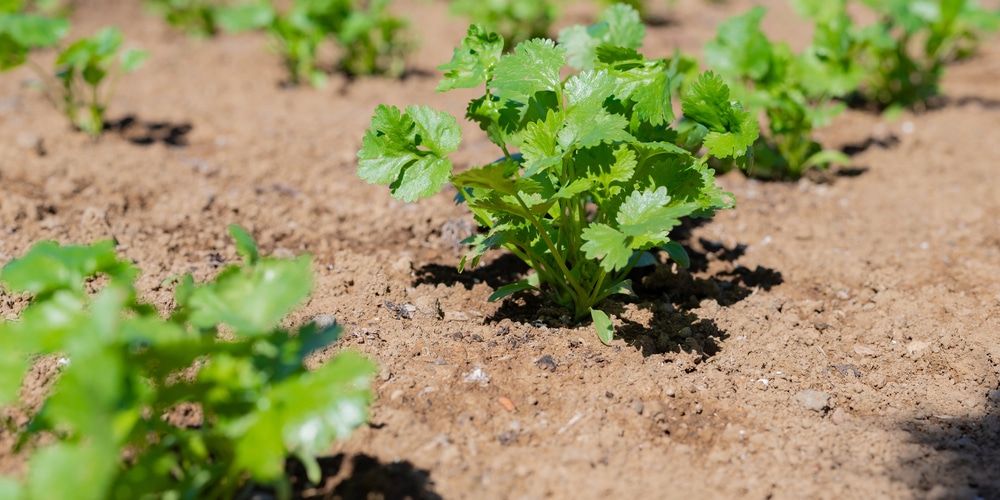Cilantro, also known as coriander, is a relatively easy-to-grow herb. Generally, you either love it or hate it, but if you decide to plant it in your yard, you shouldn’t have issues growing it. In some cases cilantro plant wilting may be a problem due to incorrect care.
Indeed, with proper care, you’ll be able to enjoy the tangy flavor of this plant for your recipes whenever you need it. After all, cilantro is a prolific producer, meaning you can enjoy a constant supply of this herb.
But what can you do about your cilantro plant wilting? Will you be able to revert your plant to its natural condition? Don’t worry: it happens even to the best gardeners! Keep reading to learn all you should know about fixing your drooping cilantro!
Cilantro Plant Wilting
Here’s the most common causes of cilantro plant wilting and how to revive your plant.
Too Much Water
Native to Southern Europe and Asia, cilantro doesn’t need much water to thrive. The truth is that overwatering is one of the most common sources of problems when growing this herb.
Ensure you plant your cilantro in a well-draining substrate and allow the soil to dry before adding any extra moisture. Too much water will cause your plant to wilt, as its roots won’t be able to breathe or carry water to the stem and leaves.
If you planted cilantro in a container, ensure it has drainage holes. Cilantro likes moisture but doesn’t stand wet feet!
Overfertilizing
While cilantro might benefit from essential nutrients in the soil, too much nitrogen might cause it to wilt. So avoid applying products high in nitrogen. But beware: the symptoms of overfertilization are similar to those caused by a lack of nutrients in the substrate.
If your plant turns yellow and starts falling over, the cause might be either of the two. Luckily, solving the issue is usually not too challenging.
If you are using fertilizer, you might have to change the product to one with less nitrogen. Also, don’t forget to follow the instructions you find on the product label to avoid damaging your plant.
But if you suspect your substrate to be poor, consider switching to soil rich in organic matter. It will provide all the essential nutrients your herb needs without harming it.
Too Much (or Too Little) Lighting
Usually, cilantro will perform well in various climates and weather conditions. However, you might have to adapt its living conditions depending on where you live. Indeed, while these herbs need lots of sunlight to thrive, they might suffer from the heat.
If you live in a hot region, you may have to move your cilantro to a shadier location over the summer to prevent it from wilting, drooping, and bolting.
Also, consider adding a thick layer of mulch around your plants. Doing so will keep the temperature stable and protect your plants from excessive heat. Additionally, it will increase water retention and improve drainage, keeping your plants moist for longer.
However, if you live in a region where summer is mild, you should plant your herb under the full sun. Inadequate lighting might halt your cilantro’s growth and cause its leaves to wilt.
Pests and Diseases
While cilantro isn’t challenging to grow, you will have to pay attention to pests and diseases. Besides the fungal infections that might arise from overwatering, keep an eye out for powdery mildew and bacterial leaf spot.
These infections might cause stunted growth and wilt of the new leaves. Don’t forget to rotate your herb regularly to ensure adequate airflow and prevent such diseases.
Pests are not common issues with cilantro. However, your plant might receive attacks from worms, aphids, or cabbage loopers. If you are struggling with attacks from pests, apply organic pesticides (as you will consume your plant’s leaves).
Such products might take longer to be effective and will require frequent applications.
Lack Of Pruning
Don’t forget that your cilantro will require regular pruning to stay neat and healthy. This practice will also prevent bolting, which causes rapid blooming and impairs the flavor of leaves. Prune your plants every couple of weeks to promote healthy growth and more flavorful leaves, which will make your dishes tastier.
You can remove up to half of the leaves with every pruning. You can use fresh cilantro for around a week. Don’t forget to freeze the leaves you won’t use within that time to keep them fresh for longer.
Related Article: When to Transplant Coriander Seedlings?


